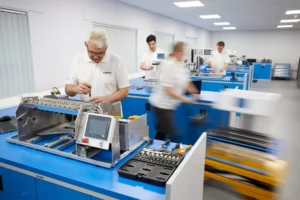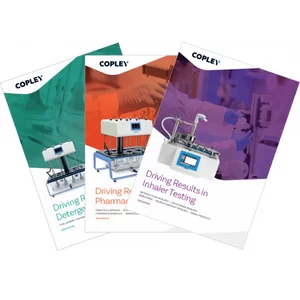Compendial methods for delivered dose uniformity call for extensive firing to waste; automation makes light work of the task.
USP <601> ‘Delivered Dose Uniformity’ includes dose uniformity over the entire unit life for pressurised metered dose inhalers (MDIs), requiring the collection of one dose from the start and one dose from the end of unit life as per the label claim, from each of 10 separate containers. Similarly, Ph.Eur. 671 calls for collection of the first three, the middle four and the last three doses, in accordance with the label claim, from a single inhaler. The guidance is to discharge all other doses to waste.
This means, conservatively, and assuming a label claim of 100 actuations, firing close to 1000 actuations to waste for quality control of a batch under the USP method. Assuming the standard guidance to wait no less than 5 seconds between actuations is followed, this equates to ∼3-4 hours work for an analyst depending on shake duration and rest periods – half a day just firing MDIs to waste! That’s a daunting prospect but it doesn’t have to be. Automating wasting can transform your workflow and productivity, while at the same time benefiting data quality.
Actuating an inhaler – what’s involved?
An examination of the steps associated with the actuation of an inhaler reveals a multi-step procedure with plenty of scope for variability in:
- Shaking technique – speed, angle and duration
- Actuation profile – the force-time profile applied when depressing the canister
- Time delays – between shaking and firing, and between repeat firings
- Storage conditions – notably the temperature and orientation at which the inhaler is kept when not in use
All these sources of variability potentially impact the characteristics of the delivered dose. For example, differences in how a suspension-based MDI is shaken can alter intimate mixing of the formulation ingredients and by extension dispersion dynamics, while the wait time – between shaking and firing – may determine the likelihood of settling or creaming. The length of time between repeat firings can influence the degree of chilling and consistency of valve metering for all types of MDI. Pharmacopoeial advice to wait for five seconds between actuations to avoid excessive cooling of the cannister directly reflects this last point.
It’s therefore desirable to eliminate such variability during testing, for both dose collection and wasting.
With manual actuation, achieving this goal requires different analysts to perform identically and repeatedly, time after time. And in truth, humans simply aren’t very good at that, even when highly motivated. Repetitive tasks such as these are prime candidates for automation.
The challenge and importance of firing to waste
Firing to waste requirements drive home what manual actuation can mean in terms of day-to-day analyst practice. Much repetitive shaking, consistent force application even when tired, and exacting attention across a monotonous test schedule. Maintaining motivation and focus is definitely a challenge, as is the risk of Repetitive Strain Injury (RSI).
And it’s important to recognise that firing to waste under representative conditions is just as important as representative actuation of the doses required for collection and measurement. Because unrepresentative wasting can affect the remaining doses. For example, if wasting is carried out under conditions that mean marginally less efficient release of the active ingredient, due to settling for instance, then the amount of active left in the device will be unrealistically elevated. Unrepresentative wasting translates directly into unrepresentative measurement.
Conversely, eliminating variability in MDI actuation enables more robust investigation of variables of interest such as formulation composition or device geometry and indeed, the impact of patient practice. It is only with a baseline measured under consistently representative actuation conditions that the effect of the outlined variables associated with patient technique can be assessed.
What can automation solutions provide?
Automated shake, fire, and flow control platforms ensure that every actuation of an MDI is carried out under identical, closely controlled test conditions, with models such as the Vertus® III+ also incorporating shot weight measurement. Single station solutions such as this make it easy to step through a dosing schedule for a single device, including wasting, but when it comes to test requirements with an extensive firing to waste requirement, a multi-station option like DecaVertus® III can pay dividends.

Above you can see the DecaVertus III wasting ten MDIs simultaneously, under the same, repeatable conditions. Furthermore, test conditions are strictly analogous to those applied by our single station platform, Vertus III/Vertus III+, streamlining method transfer between the two to implement a testing schedule that is both efficient and effective.
The bottom line
It’s easy to envisage the transformation associated with automating MDI actuation with respect to beneficial effects on analyst practice and productivity. Improved health and safety, minimal training requirement and enhanced motivation are all significant gains though their impact may be hard to monetise.
However, we also have data that quantify the size of potential savings. In a back-to-back study of delivered dose and aerodynamic particle size distribution measurement for an MDI, automating actuation resulted in a time saving of 30% relative to manual actuationi. This is a substantial gain and along with it came improved precision in dose uniformity, impactor mass balance, and impactor sized mass. Figures such as these allow us to securely determine the economic benefits of automating actuation and demonstrate a healthy return on investment for automated shake, fire and flow control platforms.
In conclusion
Automating MDI actuation, especially for wasting, is straight forward and will simultaneously enhance data integrity, lab throughput and analyst safety, motivation and productivity. I’d highlight it as one of the earliest and easiest automation strategies to consider if you need to boost productivity or reduce out-of-specification results. Our article ‘Perfect Timing for the Automation of OINDP Testing’ provides more detail if you’re interested, or look out for further blogs on the topic of semi-automation to learn about other highly productive, off-the-shelf solutions.
iA Sule et al ‘Comparative evaluation of automation shake and fire system vs. manual inhaler for pMDI inhaler’ Respiratory Drug Delivery 2016.








